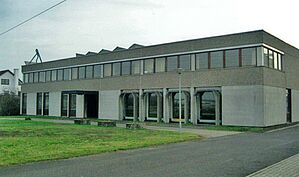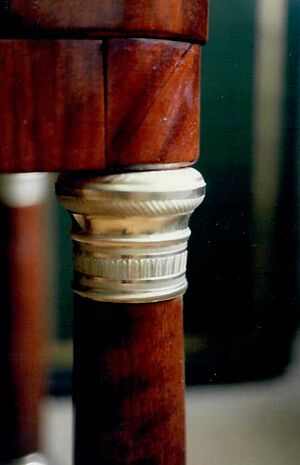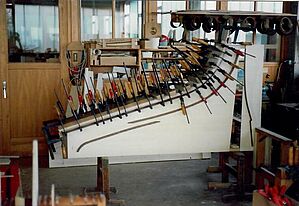A2 The apprenticeship
In short, the best possible start for those interested in cultural history. Equipped with modern equipment where necessary, but at the same time consciously maintaining traditional manufacturing methods, whereby it is part of the nature of a manufactory that every work step is carried out by specialists who have been in their profession for many years. Parallel to the first training in handling the Fugbank and other basic carpentry work, there was contact with a wide variety of historical originals, the scientific processing of which fills volumes, and in particular appreciation of this cultural heritage, one of the most important specialist libraries was created over several generations. Science, research and craftsmanship are closely related in this family business and the Neupert collection of instruments today makes up a significant part of the holdings of the Germanic National Museum in Nuremberg.

Wolf Dieter Neupert on the Neupert-Virginal after A.Gheerdinck
A more differentiated view is only possible from a certain time interval. The young company benefited - meaning the new company building at Zeppelinstrasse 3 in Bamberg - from the wealth of experience of those employees who had completed their apprenticeship in the old company on Kaulberg (founded in 1868) or had previously worked in other areas.

Company building J.C. Neupert, Zeppelinstrasse 3, Bamberg, commissioned in 1977
Many traditional handicraft techniques were still practiced in the Franconian countryside. It was therefore worthwhile to seek out retired employees for further training in this regard. Alois Reder - former "Neupertianer" - was a trained wood sculptor and mastered the polishing of lacquer by hand. Arnold Schramm, who was responsible for the production of soundboards, reported on his experiences in mill construction, the bending behavior of wood under the influence of moisture and heat, and demonstrated a special knowledge of the material through compassionate handling: "I always compare wood with people," emphasized he often. He was interested in the growth of the wood because it revealed its properties to him. Schramm's manner of dealing was careful, thoughtful and forward-looking. This made rework and corrections unnecessary.
How the material properties of a soundboard change when rubbing along the grain with linden wood shavings and what shine is created on its surface, everyone who has taken care of the matter for a few hours gets an idea of it. There would be little point in writing lengthy essays on the appropriate consistency of hot glue or polishing pad - when does it apply, when is polishing oil, benzoin, or pumice powder appropriate, for reading alone will not accomplish anything. These are the empirical values that are lost with the increasing use of machines, and a view from a great distance makes it clear that the market has now been flooded with sad mass-produced and disposable products from low-wage countries. The sensitivity of the next generation will remain underdeveloped without support. This becomes particularly clear when there is no musical foundation.
At that time, thoughts about the responsible use of resources were already inherent in those who had to lament a loss with every modernizing intervention in the work processes and this loss affected many aspects of their lives, especially their values. The complaint about a turned work in which the entasis of a column was not taken into account due to ignorance and lack of attention to the original is particularly memorable. Four aspects could be observed here: the devaluation of the material, the deprivation of beauty through ignorance, the disregard for cultural heritage and the personal injury of the client. It was an experienced journeyman, Herbert Kappel, who drew the author's attention to this incident and lamented the decline of his guild.

Fortepiano by Conrad Graf, detail
It would have required prophetic skills to foresee social developments. It was never possible to ignore them. Times of upheaval turn those who experience them into observers and witnesses of the overarching contexts they bring about, and a company that has dedicated itself to the manufacture of historical instruments and wants to survive on the market is by definition exposed to a special ordeal. For this reason alone, the preservation of cultural assets and their research deserve public funding.


Copy of a fortepiano after Conrad Graf in the workshops for historical keyboard instruments J.C. Neupert, workplace of Herbert Kappel 1988
After the master's examination, the author returned to the training company. After the master craftsman's certificate was no longer recognized as an admission requirement for training as a restorer - for the reasons see Blog 3 - the decision was made to pursue a career in cultural studies. At that point at the latest, the direction of movement against the zeitgeist was established.

Dr. Hubert Henkel * 09.02.1937 - † 05.06.2013
The trigger was the encounter with Dr. Hubert Henkel, who examined a harpsichord from the Neupert Collection that had been converted into a fortepiano. As part of this event, piano professionals experienced how historical instruments can still be handled and what information they reveal if you approach them with meticulousness and almost criminal flair. However, the time factor should no longer play a role. Among other things, the mass analysis introduced by Herbert Heyde was used.
Appropriate professional training was also a topic of discussion. Hubert Henkel considered it a special benefit to have completed an apprenticeship as a carpenter before studying musicology and recognized the desideratum of an art-scientific approach, which is why the author decided on the subject combination: art science, folklore and building research. I am still extremely grateful today for the far-sightedness of this recommendation.

